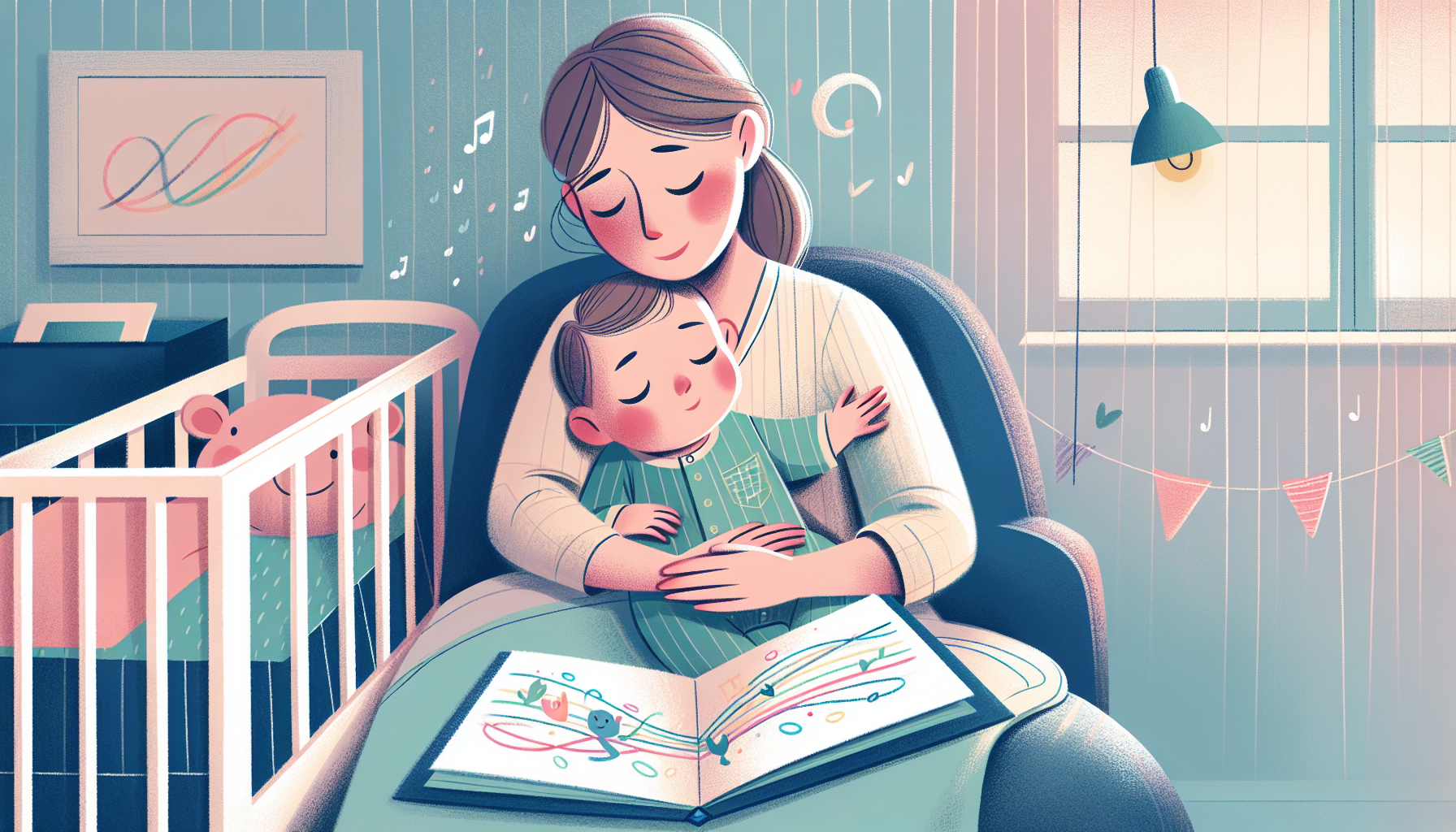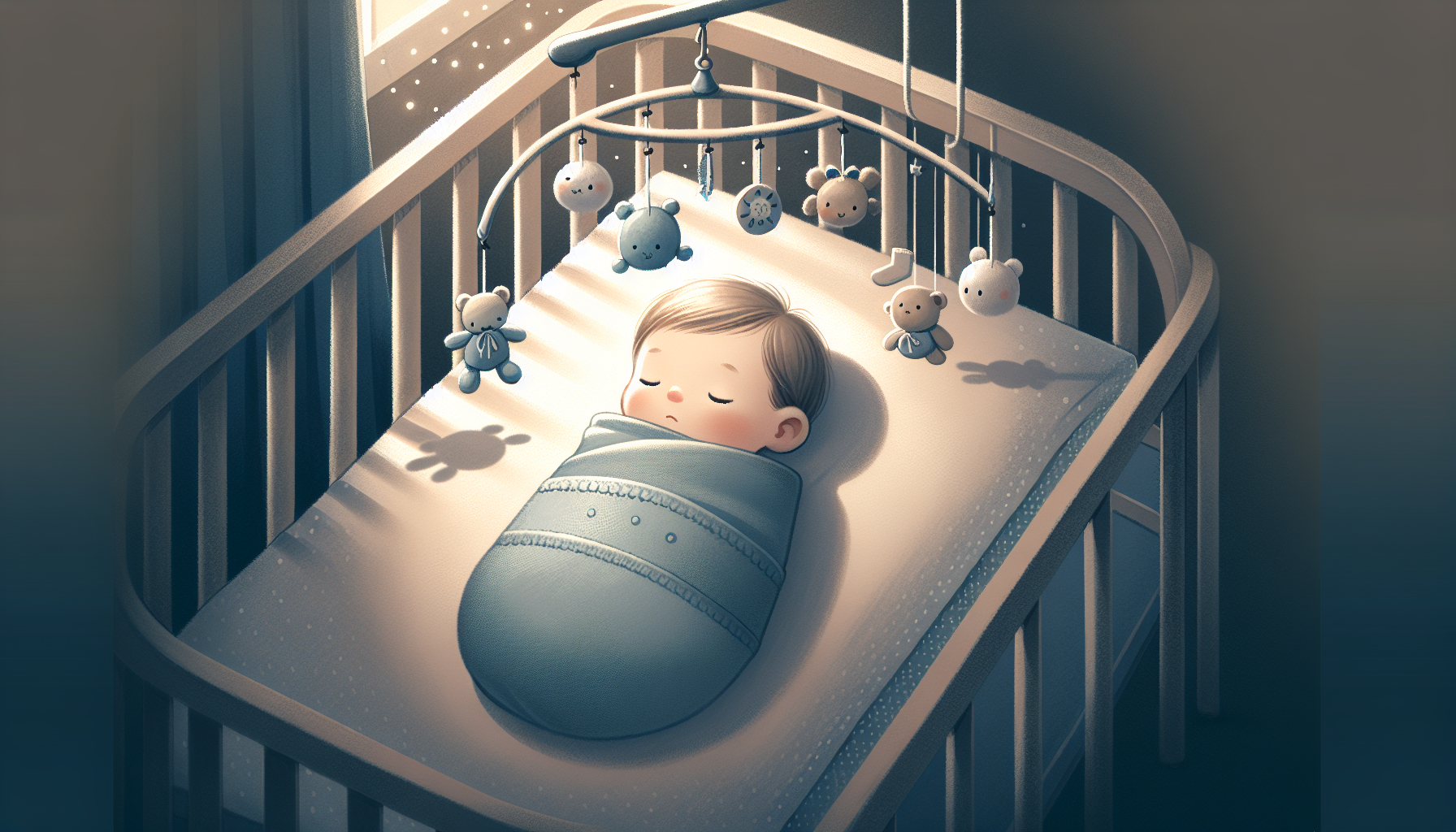
How much sleep does a 12 month old need, and how should their day be structured to meet this need? Understanding baby sleep patterns and schedules is crucial for their healthy development.
In answering this primary question for parents and caregivers, we’ll provide a streamlined “sleep schedule for 12 month old” that aligns with their developmental needs—detailing their total hours of sleep, distribution between naps and night, and tips to establish and maintain this routine. Keep reading for a clear, easy-to-follow framework that supports your child’s growth and your family’s well-being without the fluff.
Key Takeaways
-
A 12-month-old should get 13-15 hours of sleep, with 10-12 hours at night and 2-3 hours of daytime naps following a morning and afternoon schedule.
-
Consistent bedtime routines, such as a calming sequence and putting babies to sleep drowsy but awake, help establish healthy sleep patterns and independence.
-
When facing sleep challenges such as the 12-month regression and separation anxiety, maintain a consistent sleep schedule and consider sleep training with methods like ‘Cry it Out’ or Graduated Extinction.
Decoding the Ideal 12 Month Old Sleep Schedule

Navigating the sleep maze of a 12-month-old calls for a blend of science and intuition. At this tender age, your little one needs about 13-15 hours of total sleep within a 24-hour period. This sleep allocation is spread between nighttime sleep and daytime naps, usually two, amounting to 2-3 hours.
A well-calibrated bedtime between 7:00-8:00 pm aids in falling asleep and staying asleep. Now, let’s delve deeper into these components of their ‘sleep blueprint.’
Determining Nighttime Sleep Needs
When the stars twinkle, your little star needs a good night’s sleep to replenish energy for another day of exploration. Most 12-month-old babies need between 10 to 12 hours of nighttime sleep. The ideal bedtime for your baby falls between 7 p.m. and 8 p.m.. If your baby struggles to fall asleep or experiences disrupted sleep, an earlier bedtime may result in more adequate night sleep.
But what about those daytime snoozes? Let’s unravel the mystery of daytime naps next.
Daytime Naps Demystified

Daytime naps are more than just breaks for you; they are crucial for your 12-month-old’s growth and development. Your little one typically takes two naps a day, contributing to a total daytime sleep duration of between 2.5 to 3 hours. Timing is key here- the morning nap should follow a predictable schedule after morning wake-up, and the afternoon nap should conclude by late afternoon to maintain a healthy bedtime routine. So, how many naps should your child take? As mentioned, two naps are ideal for their development.
Now, with daytime and nighttime sleep sorted, let’s tie them together with a soothing bedtime routine.
Bedtime Routine Essentials
A delightful journey to dreamland begins with a calming bedtime routine. This routine is a consistent and soothing sequence of activities leading up to sleep time. The American Academy of Pediatrics suggests babies should be put to sleep drowsy but awake to foster sleep independence. This way, your little one learns to associate bedtime with relaxation, making the transition from wakefulness to sleep smoother and improving overall baby sleep quality.
Crafting Your Baby's Daily Sleep Blueprint

Armed with knowledge about nighttime sleep, daytime naps, and bedtime routines, it’s time to assemble these components into your baby’s daily ‘sleep blueprint.’ This blueprint is a balanced sleep schedule custom-made for your baby’s unique needs. It includes a wake-up time around 6 to 7am, followed by appropriately timed naps, and a bedtime between 7 and 9pm.
Tailoring this sample sleep schedule to your baby’s individual sleep needs and awake times ensures a harmonious balance between rest and activity. Understanding and implementing a daily sleep blueprint is crucial for overall baby sleep health, guiding parents in creating effective sleep schedules and addressing common sleep challenges.
Morning Wake-Up and First Nap
The dawn of a new day calls for a fresh start. A typical morning rise time for a 12-month-old is around 6:30 AM. Following this wake-up, your baby needs their first nap at about 9:45 AM, which follows approximately 3.25 hours after waking.
Keeping these awake windows in mind ensures most babies are sufficiently tired for the first nap, setting the tone for the rest of the day.
Afternoon Nap Strategies
As morning transitions to afternoon, it’s time for your baby’s second nap. Ideally, this nap should start around 2:15 PM, following 3.5 hours after the end of the first nap. Properly timed afternoon naps can help prevent your baby from becoming overtired by evening.
In case your baby is transitioning to a single nap, an earlier bedtime may be necessary to counteract potential overtiredness from missed or short afternoon naps.
The Journey to Night Slumber

As the sun dips below the horizon, it’s time to gear up for the journey to night slumber. This journey involves a sequence of soothing activities to prepare your baby for a restful night. The sleep preparation process ideally starts around 6:30 PM, with the goal of having the child asleep by 7:15 PM.
A consistent and structured evening routine aids in cueing the baby that bedtime is approaching and enhances the quality of night slumber.
Navigating Nap Transitions: From Two to One
As your baby grows and their sleep patterns evolve, you may notice signs that they are ready to transition from two naps to one. Recognizing these signs and knowing how to adjust the sleep schedule can make this transition smoother for both you and your baby.
Let’s understand the signs of nap transition and discuss a gradual approach to adjusting the sleep schedule.
Recognizing Signs for Nap Transition
Recognizing the signs of nap transition is crucial in ensuring a smooth transition for your baby. These signs may include:
-
Trouble falling asleep at nap times
-
Nap refusal
-
Shorter naps
-
The need for later bedtimes to fit in two naps
-
Disruptions in nighttime sleep such as waking up early
By observing these signs and understanding their implications, you can make a well-informed decision about your baby nap transition.
Adjusting the Sleep Schedule Gradually
Transitioning to one nap is not an overnight process, but a gradual adjustment that requires careful planning. Here’s a step-by-step guide to help you:
-
Start by delaying the morning and afternoon naps by 30 minutes for three days, with the afternoon nap being capped at 15-20 minutes.
-
Gradually shift the morning nap later each day, aiming for the nap to occur halfway through the day.
-
Eventually, establish a midday nap around 5.5 hours after morning wake-up time by day 10.
Remember, consistency is key in this transition, and it may take up to 8 weeks for your child to fully adjust to the new nap schedule.
Overcoming Common Sleep Hurdles at 12 Months
Even with a well-planned sleep schedule and consistent routines, 12-month-olds may face common sleep hurdles such as sleep regression and separation anxiety. These challenges can disrupt your baby’s sleep patterns, but with the right strategies, they can be managed effectively.
Let’s understand these sleep hurdles and discuss coping strategies. Overcoming these hurdles is crucial for ensuring better baby sleep by establishing a healthy sleep schedule that addresses common concerns like weaning the morning nap and managing sleep regression.
Coping with the 12 Month Sleep Regression
The 12-month sleep regression is a phase where your baby may experience sudden changes in sleep patterns due to developmental leaps. Signs of this regression may include:
-
more frequent nighttime awakenings
-
difficulty calming down
-
resistance to sleep at bedtime
-
changes such as fighting naps or bedtime
Maintaining consistent bedtime routines and a steady sleep schedule helps mitigate these sleep disruptions, making it important to prioritize sleep schedules.
Easing Separation Anxiety at Bedtime
Separation anxiety at bedtime can be a hurdle for many 12-month-olds. Using a consistent goodbye ritual can help babies understand and get accustomed to the idea of separation at bedtime, reducing anxiety. Practicing separation during the day can ease the anxiety associated with nighttime separation, making bedtime less stressful for the child.
During nighttime awakenings caused by separation anxiety, keeping the lights off and the environment calm and quiet is advisable.
Sleep Training Considerations for the 12 Month Old
While consistency and routine are vital for managing your baby’s sleep, there may come a time when sleep training becomes necessary. This involves teaching your baby to soothe themselves to sleep, a critical skill that can help manage issues such as sleep regression and separation anxiety.
Let’s discuss when it’s time for sleep training and how to choose the right method on your journey to sleep train your child. Properly implemented, sleep training can significantly enhance baby sleep by establishing healthier sleep schedules and addressing common sleep challenges.
Is It Time for Sleep Training?
Determining when it’s time for sleep training is crucial. The recommendation is to wait until a baby is at least 5 months old before starting sleep training to coincide with developmental progress and sleep cycle maturation. However, sleep training can be successfully implemented for children as old as 5 years. It’s essential to ensure your baby is healthy before beginning sleep training and to consult with a pediatrician if there are any health concerns.
Choosing a Sleep Training Method
Choosing the right sleep training method can make the process much smoother. Sleep training methods suitable for 12 month olds include:
-
‘Cry it out’
-
Graduated extinction
-
The chair method
-
Pick up, put down techniques
The duration to see results from sleep training can take from a few days to a few weeks, largely depending on whether gradual or extinction methods are used.
Tailoring Sleep Tools and Environment
Apart from the sleep schedule and training, the right sleep tools and environment play a crucial role in your baby’s sleep. Sleep aids like sleep sacks and white noise machines can enhance sleep quality by providing a snug environment and masking disruptive noises.
Let’s discuss how to select appropriate sleep aids and prepare the ideal sleep setting.
Ensuring the right environment is foundational for promoting healthy baby sleep, addressing common concerns such as sleep regression and transitioning sleep schedules.
Selecting Appropriate Sleep Aids

Selecting the right sleep aids can make a world of difference in your baby’s sleep quality. Introducing a sleep sack can be a part of transitioning from swaddling as babies show signs of rolling, and these are suitable for babies over one year old.
When introducing sleep sacks, it is crucial to ensure your baby’s comfort by selecting a proper fit and cozy materials.
Preparing the Ideal Sleep Setting
Creating an ideal sleep setting is just as important as setting the right sleep schedule. Dimming lights as part of the evening routine can facilitate sleep onset for a 12-month-old. The use of white noise helps signal to a 12-month-old that bedtime is approaching and masks disruptive household or outdoor sounds.
For safety and efficacy, a sound machine should be placed at least 7 feet away from the child’s sleep area and positioned between the child and the source of noise.
Maximizing Rest on Non-Daycare Days
Even on non-daycare days, it’s important to maintain the same wake-up time and bedtime for a 12 month old to ensure a stable sleep rhythm. Consistency in nap times is also crucial on non-daycare days to prevent over-tiredness and difficulty falling asleep at night.
On weekends or non-daycare days, parents can shift bedtime slightly later to allow for more family time, but it’s important to maintain the usual number of sleeping hours.
In addition to routine and environment, nutrition plays a key role in your baby’s sleep. A bottle of Else Toddler formula can be a helpful supplement to ensure your 12-month-old gets the nutrition they need for a restful sleep.
Else Toddler formula is designed to supplement the diet of toddlers aged 1-3 years. Being lactose-free and dairy-free, this formula is suitable for those avoiding both lactose and dairy. Proper nutrition with Else Toddler formula can contribute to better baby sleep by addressing common sleep-related challenges and supporting healthy sleep schedules.
Summary
Mastering your 12-month-old’s sleep schedule calls for a blend of science, intuition, and a good dose of patience. With understanding your child’s sleep needs, crafting a daily sleep blueprint, navigating nap transitions, overcoming sleep hurdles, considering sleep training, and tailoring sleep tools and environment, you can ensure your little one gets the rest they need. Remember, every baby is unique, and what works for one may not work for another. So, here’s to finding the perfect sleep rhythm for your baby and to peaceful nights and joy-filled days!
Frequently Asked Questions
How much sleep does a 12-month-old need?
A 12-month-old needs about 13-15 hours of total sleep within a 24-hour period, including night sleep and daytime naps to support their growth and development. It's important to prioritize their sleep at this age.
How can I ensure my baby gets enough daytime sleep?
Make sure your baby has two naps a day, totaling 2.5 to 3 hours of daytime sleep, and time the naps based on their awake windows to ensure they're tired enough.
What are the signs of nap transition?
If your baby is experiencing trouble falling asleep at nap times, nap refusal, shorter naps, the need for later bedtimes to fit in two naps, and disruptions in nighttime sleep such as waking up early, these may be signs of nap transition. It's important to look out for these signs as they can indicate that your baby is ready to transition to fewer naps.
What is sleep training and when can it be started?
Sleep training is about teaching your baby to soothe themselves to sleep. It can be started when your baby is at least 5 months old, and can be continued up to 5 years old.
How can Else Toddler formula help with my baby's sleep?
Else Toddler formula can support your baby's nutrition for better sleep by providing essential nutrients. It is specifically designed for toddlers aged 1-3 years and is free from lactose and dairy.
The content and advice provided in this article is for informational purposes only and is not a substitute for medical diagnosis, treatment, advice for specific medical conditions. Always consult a pediatrician to understand the individual needs of your child. The article expresses the views of the brand editor.




